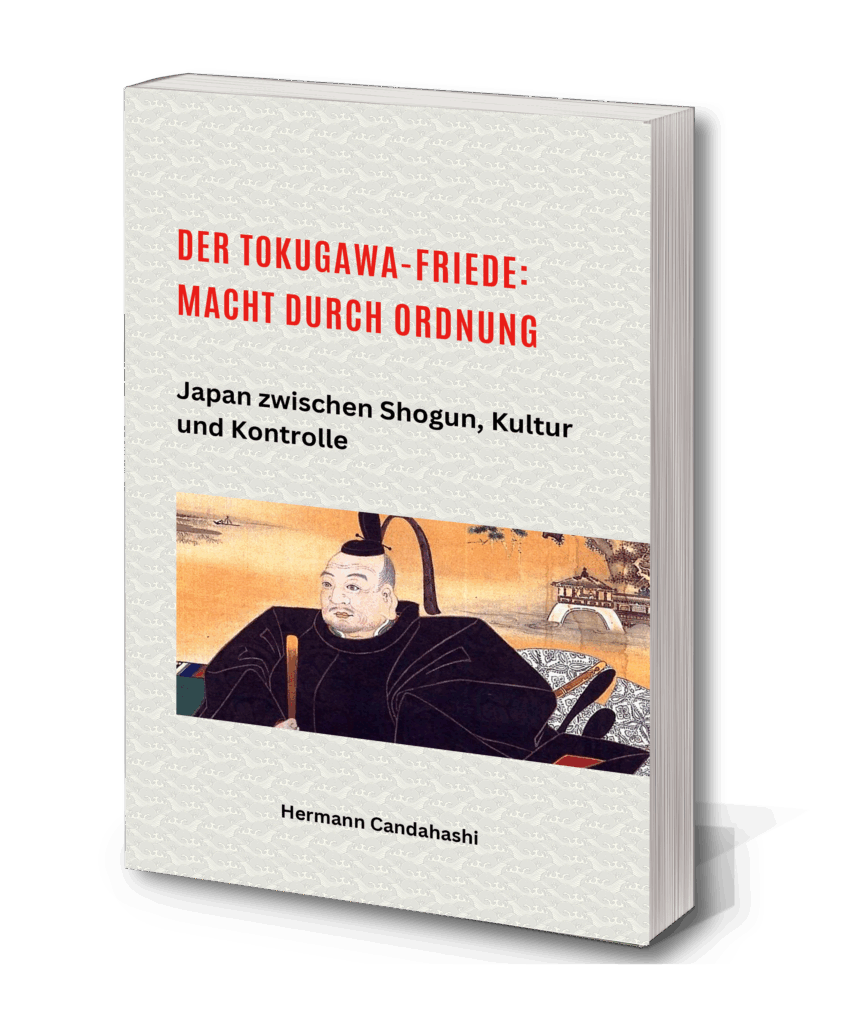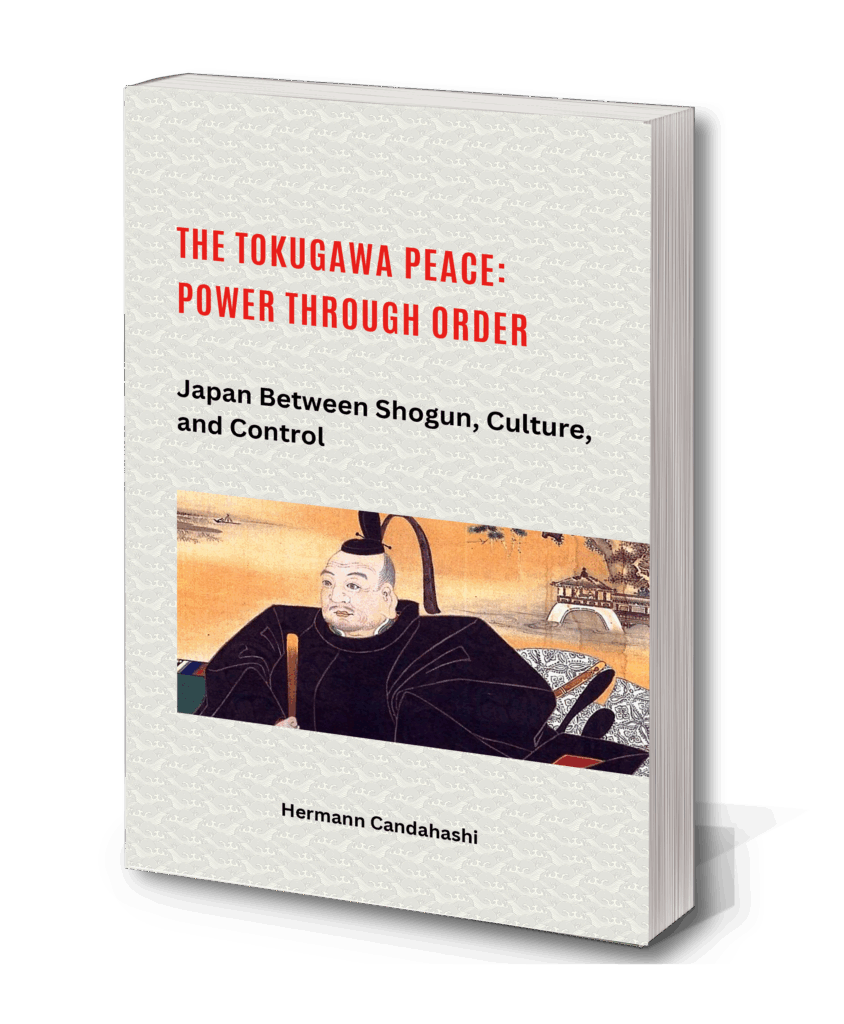

The Tokugawa Peace: Power Through Order – Japan’s Time Between Shogun, Culture, and Control
Immerse yourself in the fascinating world of the Tokugawa shogunate and experience the era of peace that shaped Japan for over 250 years! “The Tokugawa Peace: Power Through Order” transports you to the Edo period, an era of stability, strict social order, and cultural flourishing. This book is a must-read for history buffs, Japan lovers, and anyone who wants to unlock the secrets of one of Japan’s most influential eras.
Why this book?
Learn how Tokugawa Ieyasu and his successors created a stable Japan through wise policies, isolationism (sakoku), and feudal control.
Cultural Depth: Discover the roots of samurai culture, bushido, Zen Buddhism, and Confucianism, which continue to shape Japanese identity today.
Lively narrative: An exciting blend of historical facts and captivating stories about shoguns, daimyo, and life in the Edo period.
SEO-optimized for interested readers: Whether historians, Japanese studies students, cultural scholars, or travelers to Japan – this book appeals to a broad audience.
What makes this book unique?
Comprehensive insights: From the power politics of the Tokugawa to the cultural flowering of the Edo period – this book offers a holistic perspective.
Reader-friendly and well-founded: Perfect for experts and laypeople alike, with clear language and in-depth analysis.
Relevant for today: Understand how the Tokugawa principles of order and control influence modern Japanese society.
Let “The Tokugawa Peace: Power Through Order” transport you to a time when shoguns, samurai, and strict social structures determined Japan’s destiny. Discover the roots of one of the most fascinating chapters in world history! Perfect for history buffs, Japan enthusiasts, and anyone seeking deeper insights into the Edo period.
An Excerpt:
The Edo period, which shaped the face of Japan for over two and a half centuries from 1603 to 1868, is one of the most fascinating chapters in world history. It is known as an era of peace, cultural flourishing, and strict social control. The Tokugawa shogunate, founded by Tokugawa Ieyasu after the decisive Battle of Sekigahara, established a unique system of government based on the balance of power, loyalty, and order. This so-called “Pax Tokugawa” was not peace in the Western sense of free development or democratic participation, but rather a state of controlled tranquility based on an elaborate system of surveillance, ideological indoctrination, and hierarchical social structure.
This book aims to illuminate the various facets of this complex era. How could a country previously rocked by decades of war establish such stable rule? What means of control and organization did the Tokugawa shogunate use to maintain this system? And what tensions existed between cultural flourishing, economic development, and social oppression?
In the coming chapters, we will examine not only the political and military genius of Tokugawa Ieyasu, but also the mechanisms by which his successors maintained a balance between central authority and regional autonomy for centuries. We will also analyze how the shogunate created stability through a rigid social order-the division of society into samurai, farmers, artisans, and traders-while simultaneously hindering social advancement.
Particular attention will be paid to cultural life in the Edo period. Despite-or perhaps because of-the strict control over education, art, and religion, a cultural wealth developed during this period that continues to shape Japan’s identity to this day. The development of kabuki theater, haiku poetry, and ukiyo-e painting are just a few examples of the cultural flowering that flourished beneath the surface of political austerity.
Last but not least, this work also sheds light on the tensions and crises that ultimately led to the end of Tokugawa rule. Increasing pressure from foreign powers, internal economic disparities, and social unrest tested the seemingly unshakable system and ultimately culminated in the Meiji Restoration-a turning point that set Japan on the path to modernity.
Looking back today on the more than 250 years of the Tokugawa period in Japanese history, it is not easy to capture the essence of this era in a single term. Was it peaceful or repressive? Was it culturally flourishing or characterized by stagnant control? Was it a time of order or social rigidity? This era, which lasted from 1603 to 1868, is often described as a period of so-called “Great Peace.” Yet this peace was not the result of natural social development, but rather the product of a tightly controlled and well-conceived power structure. It was a peace that arose not despite the repression, but precisely because of it.The Tokugawa shogunate, founded by Tokugawa Ieyasu after his decisive victory at the Battle of Sekigahara, was not a mere political restructuring. It was a conscious response to centuries of civil war, to the Age of Warring States (Sengoku period), which had torn Japan into countless factions. The centralized power, established in the capital city of Edo (present-day Tokyo), imposed a previously unprecedented system of surveillance, isolation, and social hierarchy that produced both internal security and cultural flourishing-albeit at a high price.
In retrospect, the Tokugawa regime appears almost like a social clockwork, in which every class-from warriors to farmers to merchants-had its firmly assigned place. This order, however, was not static. It was permeated by subtle dynamics, by veiled conflicts, by the struggle for identity and meaning in a world that was constantly changing beneath the surface, even though it appeared immutable on the outside. The peace of the Tokugawa was a paradoxical peace: one maintained through control, yet still offering space for cultural expression; one characterized by social constriction, yet allowing for creative freedom in art, literature, and philosophy.
This book invites the reader to understand the complex reality of this era in all its depth. It is not simply about tracing political structures or celebrating cultural achievements.
Rather, the following presentation aims to paint a vivid picture of that time-an era often portrayed in a simplified manner, but in truth, one of the most complex phases in Japanese history. What does it mean to live in a society where peace is not the result of democratic negotiation, but the product of a disciplined system of power? How does it feel to exist in a world where every social movement is monitored, every outside sphere of influence is systematically excluded, and every form of individual rebellion is sanctioned?
In the following pages, we want to examine Tokugawa Japan not only as a historical phenomenon, but also as a space of experience. We want to make the voices of that time audible-of court poets and wandering monks, of impoverished samurai and aspiring merchants, of court officials, geisha, rice farmers, and revolutionaries. We want to understand what it felt like to live in Edo under the watchful eye of the Bakufu, how one moved as a citizen in a society that was seemingly unchanging and yet constantly in danger of becoming unbalanced.
We do not understand this work as a classical chronicle, but rather as a narrative analysis. It is about connections, mechanisms of power, cultural codes, and the interplay between freedom and discipline. With a popular scientific approach, supported by sound historical research, this book approaches the internal contradictions of the Tokugawa period. It shows how a fragile peace was maintained for generations, how discipline became the ideological foundation of an entire state, and how social tensions festered beneath the surface of this calm, ultimately culminating in the Meiji Restoration.
So what was this “peace” really? Was it a cultural heyday or a masquerade for political control? Was Japan’s isolation a wise protection or a straitjacket that prevented any opening to the outside world? These questions accompany us throughout the entire work and guide us to a nuanced view of a time that can still teach us much today about the relationship between order, power, and human aspiration.
This is the story of a country that forced itself into isolation in order to preserve itself-and in doing so, forged a unique path between tradition, domination, and inner peace. A story that is as fascinating as it is ambivalent.
Welcome to Tokugawa Japan,
Yours, Hermann Candahashi
